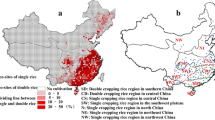Abstract
Using the detailed field experiment data from 1981 to 2009 at four representative agro-meteorological experiment stations in China, along with the Agricultural Production System Simulator (APSIM) rice-wheat model, we evaluated the impact of sowing/transplanting date on phenology and yield of rice-wheat rotation system (RWRS). We also disentangled the contributions of climate change, modern cultivars, sowing/transplanting density and fertilization management, as well as changes in each climate variables, to yield change in RWRS, in the past three decades. We found that change in sowing/transplanting date did not significantly affect rice and wheat yield in RWRS, although alleviated the negative impact of climate change to some extent. From 1981 to 2009, climate change jointly caused rice and wheat yield change by −17.4 to 1.5 %, of which increase in temperature reduced yield by 0.0–5.8 % and decrease in solar radiation reduced it by 1.5–8.7 %. Cultivars renewal, modern sowing/transplanting density and fertilization management contributed to yield change by 14.4–27.2, −4.7– −0.1 and 2.3–22.2 %, respectively. Our findings highlight that modern cultivars and agronomic management compensated the negative impacts of climate change and played key roles in yield increase in the past three decades.




Similar content being viewed by others
References
Cassman KG, Dobermann A, Walters DT (2002) Agroecosystems, nitrogen-use efficiency, and nitrogen management. Ambio 31:132–140. doi:10.1639/0044-7447(2002)031[0132:anuean]2.0.co;2
Guo J et al (2010) Significant acidification in major Chinese croplands. Science 327:1008–1010
Keating BA et al (2003) An overview of APSIM, a model designed for farming systems simulation. Eur J Agron 18:267–288
Liu L, Wang E, Zhu Y, Tang L (2012) Contrasting effects of warming and autonomous breeding on single-rice productivity in China Agriculture. Ecosyst Environ 149:20–29
Liu L, Zhu Y, Tang L, Cao W, Wang E (2013) Impacts of climate changes, soil nutrients, variety types and management practices on rice yield in East China: a case study in the Taihu region. Field Crop Res 149:40–48
Lobell DB, Hammer GL, McLean G, Messina C, Roberts MJ, Schlenker W (2013) The critical role of extreme heat for maize production in the United States. Nat Clim Chang 3:497–501
Peng S et al (2006) Strategies for overcoming low agronomic nitrogen use efficiency in irrigated rice systems in China. Field Crop Res 96:37–47
Peng S et al (2004) Rice yields decline with higher night temperature from global warming. Proc Natl Acad Sci U S A 101:9971–9975
Prescott J (1940) Evaporation from a water surface in relation to solar radiation. Trans R Soc S Aust 64:114–118
Sheehy JE, Mitchell P, Ferrer AB (2006) Decline in rice grain yields with temperature: models and correlations can give different estimates. Field Crop Res 98:151–156
Tao F et al (2014) Responses of wheat growth and yield to climate change in different climate zones of China, 1981–2009. Agric For Meteorol 189:91–104
Tao F, Zhang Z, Zhang S, Zhu Z, Shi W (2012a) Response of crop yields to climate trends since 1980 in China. Clim Res 54:233–247
Tao F, Zhang S, Zhang Z (2012b) Spatiotemporal changes of wheat phenology in China under the effects of temperature, day length and cultivar thermal characteristics. Eur J Agron 43:201–212
Timsina J, Humphreys E (2006) Performance of CERES-Rice and CERES-Wheat models in rice–wheat systems: a review. Agric Syst 90:5–31
Wang J, Wang E, Yang X, Zhang F, Yin H (2012) Increased yield potential of wheat-maize cropping system in the North China Plain by climate change adaptation. Clim Chang 113:825–840
Wei X, Zhang Z, Shi P, Wang P, Chen Y, Song X, Tao F (2015) Is yield increase sufficient to achieve food security in china? PloS One 10
Wiesmeier M, Hübner R, Kögel-Knabner I (2015) Stagnating crop yields: an overlooked risk for the carbon balance of agricultural soils? Sci Total Environ 536:1045–1051
Xiao D, Tao F (2014) Contributions of cultivars, management and climate change to winter wheat yield in the North China Plain in the past three decades. Eur J Agron 52:112–122
Xiong W, Holman IP, You L, Yang J, Wu W (2014) Impacts of observed growing-season warming trends since 1980 on crop yields in China. Reg Environ Chang 14:7–16
Zhang T, Zhu J, Wassmann R (2010) Responses of rice yields to recent climate change in China: an empirical assessment based on long-term observations at different spatial scales (1981–2005). Agric For Meteorol 150:1128–1137
Zhang X, Wang S, Sun H, Chen S, Shao L, Liu X (2013) Contribution of cultivar, fertilizer and weather to yield variation of winter wheat over three decades: a case study in the North China Plain. Eur J Agron 50:52–59
Acknowledgments
This study was supported by the National Natural Science Foundation of China (Nos. 41571088 and 31561143003). Funding support by FACCE MACSUR project through the Finnish Ministry of Agriculture and Forestry and by Luke through the strategic MODAGS project is also gratefully acknowledged. We are grateful to the two anonymous reviewers and editor for their insightful comments on an earlier version of this manuscript.
Author information
Authors and Affiliations
Corresponding author
Rights and permissions
About this article
Cite this article
Bai, H., Tao, F., Xiao, D. et al. Attribution of yield change for rice-wheat rotation system in China to climate change, cultivars and agronomic management in the past three decades. Climatic Change 135, 539–553 (2016). https://doi.org/10.1007/s10584-015-1579-8
Received:
Accepted:
Published:
Issue Date:
DOI: https://doi.org/10.1007/s10584-015-1579-8




